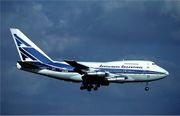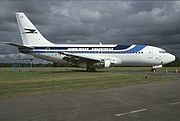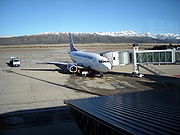Aerolíneas Argentinas
 |
||||
|
||||
| Founded | 1950 | |||
|---|---|---|---|---|
| Hubs | Aeroparque Jorge Newbery (Domestic & Regional) Ministro Pistarini International Airport (International) |
|||
| Focus cities | Ingeniero Ambrosio L.V. Taravella International Airport | |||
| Frequent-flyer program | Aerolíneas Plus | |||
| Member lounge | VIP Lounge | |||
| Subsidiaries | Austral Líneas Aéreas | |||
| Fleet size | 44 | |||
| Destinations | 56 | |||
| Parent company | Argentine Government (99.4%) | |||
| Headquarters | Buenos Aires, Argentina | |||
| Key people | Mariano Recalde (CEO) Andrés Fabre (COO) |
|||
| Website | www.aerolineas.com.ar | |||
Aerolíneas Argentinas is the largest domestic and international airline in Argentina and serves as Argentina's flag carrier.[1] The airline, based in Buenos Aires,[2] operates from hubs at Aeroparque Jorge Newbery for domestic flights and Ministro Pistarini International Airport for international services.
Contents |
History
The airline's history can be traced back to the year 1929, when carrier Aeroposta started operations. The Argentine government, recognizing Argentina's vast geographic size and the need for fast transportation links between the countryside and the larger cities, established an airline company to carry passengers and mail. The first two destinations served were Mendoza and Posadas. Frenchmen Jean Mermoz and Antoine de Saint-Exupéry were among the company's first pilots.


By 1930, two more airlines, LASO and LANE, began flights and the number of cities served by air routes in Argentina tripled. In 1945, these two airlines merged, becoming LADE (Líneas Aéreas del Estado, i.e. State Airlines). This was a well-timed move, as World War II was entering its final stages and commercial aviation was set to start a stage of explosive growth. In 1946 the first Douglas DC-3s arrived in Argentina, and Argentina's first intercontinental airline, Flota Aerea Mercante Argentina (FAMA), was created. FAMA operated Avro Yorks on services to Europe.
In May 1949, all these carriers merged under the name Aerolíneas Argentinas. Operations started on 7 December 1950. At this time, Argentina did not have suitable airport facilities, so the government of Juan Perón built Ministro Pistarini airport; General Juan Pistarini, after whom the facilities are named, designed and directed its construction. Key to the airline's growth were Alfonso Aliaga García, and Dirk Wessel Van Layden, who had been a pilot with French carrier Aéropostale (not to be confused with Aeroposta) and was influential in raising flying standards.
The DC-3 proved to be an invaluable asset for Aerolíneas Argentinas, as for many other airlines worldwide. It enabled them to fly to domestic destinations that had, until then, been unreachable – and to keep flying FAMA's international routes. Soon afterwards, Douglas DC-4s joined the fleet and services were inaugurated to Santiago de Chile, Lima, Santa Cruz, and São Paulo.
The 1950s saw the arrival of the DC-6, allowing Aerolíneas Argentinas to fly at night for the first time. Thanks to this plane, the name of Aerolíneas Argentinas was seen at terminals in New York's Idlewild airport, as well as Havana, Lisbon, London Heathrow, Dakar, and Rio de Janeiro. By the end of that decade, the Comet IV jet had begun commercial jet services worldwide, and Aerolíneas once again wanted to set the pace among South America's air companies. Airline President Juan José Güiraldes persuaded Argentina's President Arturo Frondizi to buy six of the new planes, on the understanding that Aerolíneas would pay for the planes later. And so, on 2 March 1959, 'Tres Marías', which became the first jet airplane flown by Aerolíneas, landed at Ministro Pistarini International Airport.
With these jets, Aerolíneas Argentinas kept a steady growth during the 1960s, opening routes to London, Paris, Rome, and Madrid. The 1970s saw the arrival of the Boeing 727s, 737s and 747s, a stronger marketing strategy and the introduction of new routes to Amsterdam, Frankfurt and Zurich. Aerolíneas Argentinas was featured on many Jorge Porcel movies at that time, and the began licensing toy companies to produce models of their aircraft, a practice it maintains today.
During and for some time after the 1982 Falklands War (Spanish: Guerra de las Malvinas), Aerolíneas Argentinas was banned from flying through British airspace. There used to be a flight from London Gatwick to Argentina's capital, however passengers for Argentina had to change planes at Madrid Barajas because of the ban.[3]
2009 onwards
On 16 November 2009, the last Boeing 737-200 flight operated by Aerolíneas Argentinas took place on a flight from Buenos Aires-Catamarca-La Rioja-Buenos Aires.[4]
In June 2010, Aerolíneas Argentinas launched a new livery to give the airline a more modern appearence. The new livery resembles the colour blue of Argentina's flag and the colour yellow of the sun. Subsidiary airline Austral also got the new image. Using the same livery as Aerolíneas Argentina, Austral's differs with a red line to show the difference between the two airlines.[5]
Privatization and near-collapse



On 27 December 1989 the government authorized the privatization of the airline and on 21 November 1990 Iberia acquired a 30% stake, subsequently increasing it to 83.5%. Continuing poor financial performance led Iberia to reduce its stake to 20%, which was transferred to a Spanish state holding company, SEPI, and the company was reorganized as a subsidiary of Interinvest. In July 1998, American Airlines acquired a 10% stake in Interinvest, giving it an 8.5% stake in Aerolíneas Argentinas. American has since disposed of the holding and Iberia then reduced its stake in Interinvest to 10%. Plans for employees to take an 85% share in 2000 never came to actualization.[6]
Allegations of corruption were made on the basis of the price paid by Iberia and the Spanish firm's ulterior conduct (including some convoluted lease-back operations), with the airline paying the price for its own purchase with its assets. Subsequent management by American Airlines and Spanish state owned conglomerate SEPI drove Aerolíneas Argentinas into an almost terminal crisis in 2001.
Aerolíneas Argentinas when Iberia acquired it, and when it sold it.
| Item | 1991 | 2001 | 2009 |
|---|---|---|---|
| Assets (without routes, MM US$) | 650 | ? | ? |
| Annual Balance (MM US$) | 18 | -390 | ? |
| Debt (MM US$) | ? | cc. 1000 | ? |
| Planes (owned/leased) | 28/1 | 1/43 | 17/32 |
| Flight simulators | 3 | 2 | 2 |
| Number of employees | 11500 | 6500 | 10200 |
Even though Austral formed part of a consortium along with Iberia to buy Aerolíneas Argentinas, Austral's owner sold Cielos del Sur S.A. to Iberia. The two airlines remained separate and never merged. By the late 1990s the airline was near bankruptcy; losses in 1999 where around 240 million US dollars. The Spanish government tried to sell its controlling share to American Airlines but the offer was declined.
In 2001 the airline filed for protection from creditors and parts of the business were sold off. Grupo Marsans acquired 92% in 2001 and committed to inject $50m capital with the intention of resuming long-haul services. This was realized on 6 November 2001 with a transatlantic service to Madrid.[6]
In June 2001 flights to seven international destinations were suspended and the airline went into administration. In October 2001, control of both Aerolíneas Argentinas and Austral was handed to Air Comet,[7] a consortium of the Spanish private carriers Spanair, Air Comet and travel operator Viajes Marsans, who acquired 92.1% of the shares.
After teetering on the brink of closure during most of 2001, combined with the adverse effects of the September 11, 2001, attacks on the industry and Argentina's financial meltdown of December 2001, Aerolíneas was forced to close down international services for a few days during early 2002. However, fresh capital was provided ($50 million from the Marsans Group) and the airline resumed services almost immediately. In 2002, the airline came out of administration after a Buenos Aires judge accepted its debt restructuring agreement with creditors.[8]
The airline endured a pilot's strike during November 2005. After nine days of negotiations, the airline and its pilots struck a deal.
On 21 July 2008, the Argentine government took the airline back into state control after acquiring 99.4% of the share capital for an undisclosed price. The remaining 0.6% continues to be owned by the company's employees.[9]
On 3 September 2008, Argentina's Senate approved the nationalization of Aerolíneas Argentinas and its subsidiary Austral Líneas Aéreas on a 46-21 vote in favor of the takeover.[10]
Destinations
Fleet
Current
The Aerolíneas Argentinas fleet consists of the following aircraft (at 16 May 2010):[11][12][13]
| Aircraft | In Fleet | Orders | Passengers (Business/Economy) |
Notes |
|---|---|---|---|---|
| Airbus A340-211 | 4 | 0 | 249 (32/217) | |
| Airbus A340-300 | 3 | 0 | 280 (32/248) | |
| Boeing 737-500 | 16 | 0 | 108 (8/100) | To be phased out |
| Boeing 737-700 | 12 | 0 | 128 (8/120) | 10 equipped with winglets |
| Boeing 747-400 | 3 | 0 | 421 (42/379) | |
| McDonnell Douglas MD-83 | 1 | 0 | 148 (8/140) | |
| McDonnell Douglas MD-88 | 5 | 0 | 148 (8/140) | 1 stored 3 stored at AEP |
| Total | 44 | 0 | Last updated: 16 May 2010 |
*Note: Business class is called Club Condor
Modernization
Aerolíneas Argentinas began to modernize their fleet in 2009:
- In early 2009, Aerolíneas Argentinas agreed to purchase 2 Boeing 737-700's and to lease a further 10. The new aircraft will replace the ageing Boeing 737-200 aircraft.
- On 17 October 2009, Aerolíneas Argentinas announced that they are looking for 6 Boeing 737-800 aircraft to complement the 12 Boeing 737-700's and to replace 12 of the ageing Boeing 737-500 aircraft.[14] On the same day it was also revealed that they are negotiating at retrieving 6 Airbus A330-200's and 7 Airbus A340-600 aircraft from an order placed by Grupo Marsans. With the planned long haul aircraft they want to relaunch services to Cape Town, Mexico City and New York City as well as further expansion. Aerolíneas Argentinas plans to start adding the new aircraft to the fleet in February 2010 with a delivery span of 14 to 16 months.[15]
Retired
Aerolíneas Argentinas has also operated the following aircraft:[16]
- Airbus A310-324
- Airbus A310-325ET
- Airbus A320-212
- Avro York
- Avro/Hawker Siddeley HS 748[17]
- Boeing 707-320B
- Boeing 707-320C - 2 used for Aerolíneas Argentinas Cargo[18]
- Boeing 727-23
- Boeing 727-200Adv
- Boeing 737-200 - last aircraft was retired on 16 November 2009[19]
- Boeing 737-300F - Aerolíneas Argentinas Cargo[20]
- Boeing 747SP
- Boeing 747-200
- de Havilland Comet IV
- Douglas DC-3
- Douglas DC-4
- Douglas DC-6
- McDonnell Douglas MD-82
- Short Sandringham
Accidents and incidents
- On 4 February 1970, Aerolineas Argentinas Flight 707, an Avro 748-105 crashed into the ground after the pilots lost control of the aircraft. The aircraft crashed at Loma Alta, Argentina and killed all 37 passengers and crew on board.
- On 20 February 1981, Aerolíneas Argentinas Flight 342, a Boeing 707 from Guayaquil had descended to 1,500 feet while approaching the JFK Airport in New York in a heavy fog, and was 75 seconds away from colliding with the antenna on Tower One of the World Trade Center. An alert air traffic controller, Donald Zimmerman, ordered the jet to turn right and to climb, 75 seconds before a collision would have occurred.[21]
- On 20 February 1992, shrimp contaminated with cholera was distributed on an Aerolíneas Argentinas Flight 386, a Boeing 747 bound for Los Angeles from Buenos Aires via Lima, Peru. The contaminated shrimp entered the aircraft in Lima. 76 passengers became ill after landing in Los Angeles. One of the ill passengers, a 70-year-old man named Anibal Cufre,[22] died of the illness.[23][24] Of the 336 passengers, the United States was the final destination for 297 of them. Two passengers selected Canada as their final destination, while 37 selected Japan as their final destination. The cholera on the contaminated food did not spread to other areas.[22]
According to the Aviation Safety Network database, the last accident with one of the company's aircraft with fatalities was in 1970.
Aviation Safety Network reports 42 accidents or incidents for Aerolíneas Argentinas since 1950.[25]
References
- ↑ Aerolíneas Argentinas - Flag Carrier
- ↑ "Suppliers Registration." Aerolíneas Argentinas. Retrieved on May 9, 2010. "547 Bouchard St. – 5th floor, Autonomous City of Buenos Aires."
- ↑ Aerolíneas Argentinas History
- ↑ Last Aerolíneas Argentinas 737-200 flight
- ↑ Our New Image
- ↑ 6.0 6.1 "Directory: World Airlines". Flight International: p. 48. 2007-03-27.
- ↑ http://www.fundinguniverse.com/company-histories/Aeroliacute;neas-Argentinas-SA-Company-History1.html
- ↑ Aerolíneas Argentinas history
- ↑ Argentine government buy back Aerolíneas Argentinas
- ↑ International Herald Tribune
- ↑ Aerolineas Argentinas Fleet - airfleets.net
- ↑ Aerolíneas Argentinas Fleet - CH-Aviation
- ↑ Aerolíneas Argentinas Fleet (Official Website)
- ↑ Aerolíneas Argentinas to acquire 6 Boeing 737-800 aircraft
- ↑ Aerolíneas Argentinas to try and lease 13 long haul aircraft
- ↑ Aerolíneas Argentinas retired fleet (Airbus, Boeing and McDonnell Douglas aircraft)
- ↑ History 1960-69, Aerolineas' website (Spanish) retrieved 2009-01-21
- ↑ Aerolíneas Argentinas Cargo Boeing 707-320C picture
- ↑ Aerolíneas Argentinas retires last Boeing 737-200
- ↑ Aerolíneas Argentinas Cargo Boeing 737-300F picture
- ↑ "Traffic cops of the sky", The Spokesman-Review, June 20, 1981, pC-1
- ↑ 22.0 22.1 "Cholera Kills One and Fells Many on Flight," The New York Times
- ↑ "Contaminated Food Causes Flight Fatality," FDA Consumer
- ↑ "Fatal Boeing 747 Events," Airsafe
- ↑ Aviation Safety Network report for Aerolíneas Argentinas accidents or incidents
External links
- Aerolíneas Argentinas
- Aerolíneas Argentinas workers' Union Site
- (online) Article about 50th anniversary of "Aerolineas Argentinas" - Los 50 de Aerolíneas Argentinas, "Aeroespacio" Issue 538, Nov/Dec 2000. (in Spanish)
- Aeropuertos Argentina 2000
|
|||||||
|
||||||||||||||||||||||||||||||||||||||||||||||||||||||||||||||||||